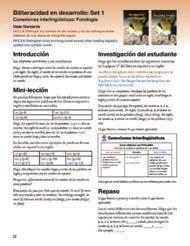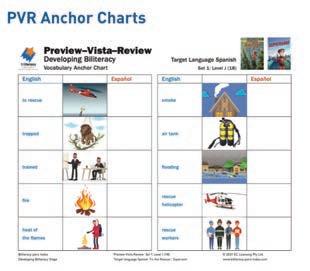





Biliteracy para todos™, your essential new resource for dual-language learning, is a uniquely designed, standards-based program carefully crafted for Spanish-English instruction, targeting language, content, and translanguaging practices. Biliteracy para todos™ provides lessons for teachers to engage bilingual learners in two related activities:









• Contrasting and analyzing the two languages of instruction
• Using their complete linguistic repertoire during whole-class and small group literacy instruction.

In Biliteracy para todos™, bilingual students are referred to as:
• Emergent bilinguals of English — students whose dominant home language is Spanish and are becoming bilinguals as they develop English through language connections. At the same time, they are further developing their home language.
• Emergent bilinguals of Spanish — students whose dominant home language is English and are becoming bilinguals as they develop Spanish through language connections. At the same time, they are further developing their home language.
• Experienced bilinguals — students from both language groups who have advanced bilingual abilities in both program languages.
Biliteracy para todos™ builds on students’ ability to translenguar to actively develop biliteracy. Translanguaging is not only about moving from one language to another, it is also about how bilingual students use language. Students use their complete language system, which is composed of features of both languages, to make sense of their world.
Biliteracy para todos™ lessons are designed for teachers working with emergent and experienced bilinguals in different educational contexts. The lessons provide intentional translanguaging opportunities, allowing bilingual learners to flexibly use their full linguistic repertoire as they become bilingual and biliterate.
In Biliteracy para todos™, biliteracy is seen from the perspectives of both the biliteracy teacher and the biliterate student.
CLC and PVR lessons create opportunities for teachers to implement their biliteracy teaching in an intentionally designed way.
Students are encouraged to become biliterate as they move through the three stages of the program’s biliteracy progression. Through this process, the students use their full linguistic repertoire to gain understanding of how English and Spanish are similar and different.
The Two Pillars of Biliteracy para todos™ Teacher Resource Books (one for CLC, one for PVR) provide complete instructional plans for each set.Biliteracy para todos™ consists of two separate resources, which are available as stand-alone products or as one comprehensive package:
• Cross Linguistic Connections (CLC) for whole or small group instruction encompasses phonology, morphology, grammar, and syntax.


• Preview-View-Review (PVR) for small group reading instruction.
Cross Linguistic Connections (CLC) is the pedagogy teachers use to guide students in noticing similarities and differences in English and Spanish phonology, morphology, grammar, and syntax as they talk about each language side by side. All students have the opportunity to develop metalinguistic awareness and, ultimately, to develop biliteracy. Teachers who create these opportunities allow bilingual learners to connect, access, and apply concepts and skills from English to Spanish, and from Spanish to English. CLC mini-lessons use the same text in English and Spanish to engage students and support them as they notice and analyze similarities and differences across the two languages.
Preview-View-Review (PVR)

Preview-View-Review (PVR) lessons provide a three-step bilingual strategy to:

1. Access the students’ home language.

2. Activate background knowledge.

3. Develop vocabulary before engaging in reading in the other language.
PVR during small group reading supports students’ thinking and talking through texts in two languages. Some lessons will begin and end in Spanish (with English in the middle), while others will begin and end in English (with Spanish in the middle).
Student Texts:
CLC and PVR sets include dozens of student texts at each stage — 480 for CLC and 432 for PVR at the Early and Developing stages and 384 for CLC and 240 for PVR at the Advanced stage. Spanish texts are matched by their counterpart texts in English, and both are included for dynamic instruction and student engagement across languages.
During the designated CLC lesson, the students work in bilingual pairs.
The teacher:
• introduces the lesson and the mini lesson
• guides and works with the students during the student investigation and the creation of the anchor chart to summarize how the languages are similar or different
• encourages the students to reflect and write independently in their journals during the review.
The teacher:
• provides initial language and literacy instruction in Spanish or English during the language arts block.
• facilitates access to biliteracy by connecting language and literacy skills previously learned in Spanish or English during the language arts block.
• engages students in discussions and explores similarities and differences between the two languages of instruction.
• creates opportunities for students to demonstrate metalinguistic awareness by applying language and literacy skills discussed during CLC lessons in the other language across all content areas.
Initial instruction of language and literacy skills in Spanish or English

Apply language and literacy skills to English or Spanish
CLC Lessons Access literacy skills previously learned in one language and engage students in bidirectional, metalinguistic conversations using their full linguistic repertoire.


PVR during small group reading supports students’ thinking and talking through texts in two languages. Some lessons will begin and end in Spanish (with English in the middle), while others will begin and end in English (with Spanish in the middle).

• During the preview, the teacher and students use the opposite language of the view to build background knowledge and vocabulary.
• During the view, the teacher works with a small group of students to support reading comprehension and language.
• During the review, the teacher and students use the language opposite of the view to allow students to clarify and extend understanding.


Visit biliteracy-para-todos.com for a multitude of downloadable tools in both English and Spanish to support your instruction. Find Anchor Charts to focus learning on grammar, vocabulary, and more. Easy-to-use Records of Biliteracy Behavior will help you track progress. Sentence Stems provide a touchstone for seeing the similarities and differences in languages.



Scan here to view Downloadable Resources or visit https://biliteracy-para-todos.myokapi.com/ program-resources/


Mercuri & Pratts are experienced educational consultants and have been a guiding force in improving student achievement, channeling the latest research into effective practices for emergent bilinguals through teaching for interdisciplinary biliteracy, dual language and language transfer. Offering an array of Professional Development modules, Mercuri & Pratts work closely with schools and families while also presenting at educational conferences such as La Cosecha and CABE. Mercuri & Pratts’ continuing work supports students in reaching academic and linguistic goals.
Dr. Sandra Mercuri is a nationally and internationally recognized consultant in the areas of second language acquisition, dual-language education, and curriculum integration for biliteracy development. Dr. Mercuri has over 30 years of experience teaching in K–12 schools and as a college professor in Argentina and the United States. She provides professional development for teachers, administrators, and parents on second language acquisition and bilingualism, dual-language education, translanguaging pedagogy, and ESL strategies. Her latest published work on biliteracy is La enseñanza en el aula bilingüe: Content, language and biliteracy (Caslon, 2020).
Vivian Pratts is an experienced bilingual teacher, elementary principal, and bilingual/ESL PK–12 director. She has over 30 years of educational experience and is currently an educational consultant. Vivian provides professional development for parents, teachers, and administrators as well as coaching principals in the areas of leadership and second language acquisition. Her current research interests include translanguaging with emergent and experienced bilinguals, and how teachers can extend and support the linguistic repertoire of students. With Sandra Mercuri, she co-authored the article Designing and Implementing Effective Professional Development and Coaching for Dual Language Programs at DualLanguageSchools.org.


Scan here or go to https://bit.ly/34oTQB4 for Mercuri & Pratts’ Biliteracy para todos™ introductory webinar!

Levels A–J (Early) or Levels I–P (Developing)
10 ‘Grab-and-Go’ Sets, each containing:
• 48 Books (12 copies each of 4 student titles in English and Spanish)
• 1 Teacher Resource Guide
The complete CLC Resources for Early and Developing provide 480 student books each, with full instructional support.


Levels N–T (Advanced)
8 ‘Grab-and-Go’ Sets, each containing:
• 48 Books (12 copies each of 4 student titles in English and Spanish)
• 1 Teacher Resource Guide
The complete CLC Resource for Advanced provides 384 student books, with full instructional support.
CLC Developing Set 10 / Level P
Levels A–J (Early) or Levels I–P (Developing)
18 ‘Grab-and-Go’ Sets, each containing:
• 24 Books (6 copies each of 4 student titles in English and Spanish)
• 1 Teacher Resource Guide
The complete PVR Resources for Early and Developing provide 432 student books each, with full instructional support.
Levels N–V (Advanced)
10 ‘Grab-and-Go’ Sets, each containing:
• 24 Books (6 copies each of 4 student titles in English and Spanish)
• 1 Teacher Resource Guide
The complete PVR Resource for Developing provides 240 student books, with full instructional support. PVR Developing Set 18 / Level P
Reading Packaging National Your Set Levels Code List Price Price
BPT Early CLC Set Levels A –J OK BPTCLC01 $3413 $3250
BPT Early PVR Set Levels A I OK BPTPVR01 $3565 $3395
BPT Early Complete Set Levels A –J OK BPTCOM01 $6925 $6595
BPT Developing CLC Set Levels I –P OK BPTCLC02 $3833 $3650
BPT Developing PVR Set Levels J –P OK BPTPVR02 $3938 $3750
BPT Developing Complete Set Levels I –P OK BPTCOM02 $7691 $7325
BPT Advanced CLC Set Levels N-T OK BPTCLC03 $3355 $3195
BPT Advanced PVR Set Levels N-V OK BPTPVR03 $2305 $2195
BPT Advanced Complete Set Levels N-V OK BPTCOM03 $5618 $5350
BPT Complete Set Levels A-V OK BPT01-03 $19,945 $18,995
Ph (866) 652-7436 | Fax (800) 481-5499 | Visit our online store or find your rep at myokapi.com
42381 Rio Nedo Temecula, CA 92590
To request your FREE sampler, go to myokapi.com/curriculum/samples
All information correct at time of printing. V2_US 11/2022